| Article ID | Journal | Published Year | Pages | File Type |
|---|---|---|---|---|
| 1716123 | Acta Astronautica | 2011 | 7 Pages |
The ultimate aim of any system designed to analyse a signal for structured and intelligent-like behaviour, is not merely to provide a Boolean filter but to have the ability to deduce what category the signal fits—language, image, music, noise, etc.—and then to decipher its contents. Up until now, my research has concentrated on the lower level universals of language structure and how they can be detected [J. Elliott, E. Atwell, W. Whyte, First stage identificaton of syntactic elements in an extraterrestrial signal, in: Proceedings of IAC’2001: the 52nd International Astronautical Congress, Paper IAA-01-IAA.9.2.07, Toulouse, France, 2001; J. Elliott, E. Atwell, Language in signals: the detection of generic species-independent intelligent language features in symbolic and oral communications, in: Proceedings of the 50th International Astronautical Congress, Paper IAA-99-IAA.9.1.08, International Astronautical Federation, Paris, 1999]. However, in this paper, I begin to look into developing techniques, which use only surface structure information deduced from the signal sample itself, for learning what underlies the higher level elements of the language (lingua ex machina) hierarchy, where syntax meets semantics. The aim therefore is to move towards developing techniques, which will unlock a signal's meaning using its internal cohesion and constraints. In doing so, I look at how the most disparate of human language orthographic forms mirror each other's underlying structure, despite their encoding strategies and how classes of words give their secrets away by the functional ‘friends’ they keep.Finally, I present techniques developed for non-language structured signals: how the statistical ‘fingerprint’ of a binary image, such as the recent challenge set by Dr. Dutil [University of Catalunya, Barcelone, Spain & ABB Bomem Inc, 2001 〈〈http://ww3.sympatico.ca/stephane_dumas/CETl/output_stream.txt〉〉] and the 1974 Arecibo transmission [Arecibo Observatory 〈〈http://www.naic.edu/〉〉], can be detected when encoded as a binary bit-stream by the analysis of its type-token distribution, and further analysis of the structure of music and how it differs from language.
